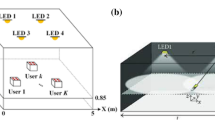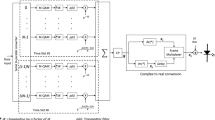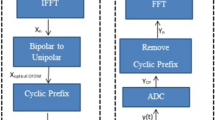Abstract
Recent developments in wireless digital communication have made Visible Light Communication (VLC) a promising technology. Comparatively speaking, the VLC system used in this task offers better performance and efficiency. In this study, a modified Optical Orthogonal Frequency Division Multiplexing (indoor VLC communication model) was proposed. To overcome channel capacity restrictions caused by a constrained LED modulation bandwidth, MIMO VLC systems must meet the high Signal-to-Noise Ratio (SNR) criteria needed for SISO channel LED lighting. Generalized Frequency Division Multiplexing (GFDM), Space–Time Block Coded OFDM (STBC-OFDM), and Electro-Optical OFDM (EO-OFDM) are frequently compared and contrasted in wideband technology (Enhanced Optical OFDM). The suggested system, when compared to other systems, increases BER (Bit Error Rate) performance and throughput for all MIMO via SISO VLC communication channel gains that may be available. The suggested approach keeps the standard method's data rate constant while BER is improved by 20 dB and 10–5. EO-OFDM offers better data rates than OFDM, but is less effective than PAPR, according to research on channels with limited bandwidth (peak-to-average power ratio). To assess the SNR throughput of the proposed EO-OFDM scheme in comparison to O-OFDM, OAK-OFDM, and PWM-OFDM in order to get a throughput of 20 Mbit/s. In comparison to MIMO-based O-OFDM, OAK-OFDM, and STBC-OFDM, the suggested EO-OFDM technology runs at speeds faster than 7.6 Mbits/s. This experiment's overall performance is superior to state-of-the-art considering that LEDs are linear and have a constrained dynamic range.










Similar content being viewed by others
Data availability
Data sharing is not applicable to this article as no new data were created or analyzed in this study.
References
Lian, J., Noshad, M., & Brandt-Pearce, M. (2019). Comparison of optical OFDM and M-PAM for LED-based communication systems. IEEE Communications Letters. https://doi.org/10.1109/LCOMM.2019.2891593
Ji, R., Wang, S.-W., Liu, Q., & Lu, W. (2018). High-speed visible light communications: Enabling technologies and state of the art. Applied Sciences, 8, 589. https://doi.org/10.3390/app8040589
Khalighi, M., Long, S., Bourennane, S., & Ghassemlooy, Z. (2017). PAM-and CAP-based transmission schemes for visible-light communications. IEEE Access, 5, 27002–27013. https://doi.org/10.1109/ACCESS.2017.2765181
Matheus, L., Borges, A., Vieira, L., Vieira, M., & Gnawali, O. (2019). Visible Light Communication: Concepts, Applications and Challenges. IEEE Communications Surveys & Tutorials. 21, 1-1. https://doi.org/10.1109/COMST.2019.2913348
Wang, Q., Wang, Z., & Dai, L. (2015). Multiuser MIMO-OFDM for visible light communications. IEEE Photonics Journal, 7(6), 1–11. https://doi.org/10.1109/JPHOT.2015.2497224
Karunatilaka, D., Zafar, F., Kalavally, V., & Parthiban, R. (2015). LED based indoor visible light communications: State of the art. IEEE Communications Surveys & Tutorials, 17, 1–30. https://doi.org/10.1109/COMST.2015.2417576
Wang, Qi., Wang, Z., & Dai, L. (2015). Multiuser MIMO-OFDM for visible light communications. IEEE Photonics Journal, 7, 1–11. https://doi.org/10.1109/JPHOT.2015.2497224
Ma, Hao., Lampe, Lutz. & Hranilovic, Steve. (2013). Robust MMSE linear precoding for visible light communication broadcasting systems (pp. 1081-1086). https://doi.org/10.1109/GLOCOMW.2013.6825136
Sung, J.-Y., Yeh, C.-H., Chow, C.-W., Lin, W.-F., & Liu, Y. (2015). Orthogonal frequency-division multiplexing access (OFDMA) based wireless visible light communication (VLC) system. Optics Communications., 355, 261–268. https://doi.org/10.1016/j.optcom.2015.06.070
Lin, S. H., Liu, C., Bao, X., et al. (2018). Indoor visible light communications: Performance evaluation and optimization. EURASIP Journal on Wireless Communication Networking, 2018, 228. https://doi.org/10.1186/s13638-018-1243-x
Li, X., Vucic, J., Jungnickel, V., & Armstrong, J. (2012). On the capacity of intensity-modulated direct-detection systems and the information rate of ACO-OFDM for indoor optical wireless applications. IEEE Transactions on Communications, 60(3), 799–809.
Li, C. P., Yi, Y., & Lee, K. S. (2015). Pilot self-coding applied in optical OFDM systems. Internationala Journal of Electronics, 102(4), 548–562.
Yang, X., Min, Z., Xiongyan, T., et al. (2012). A post- processing channel estimation method for DCO- OFDM visible light communication. In International Symposium on Communication Systems, Networks & Digital Signal Processing (pp. 1–4).
Zhang, T., Guo, S., Chen, H., et al. (2015). Enhancing the bit error rate of indoor visible light communication systems using adaptive channel estimation algorithm‟. IET Communications, 9(4), 501–507.
Lin, B., et al. (2017). Efficient frequency-domain channel equalisation methods for OFDM visible light communications. IET Communications, 11(1), 25–29. https://doi.org/10.1049/iet-com.2016.0787
Mirvakili, A., Koomson, V. J., Rahaim, M., Elgala, H., Little, T. D. C., & “Wireless access test-bed through visible light and dimming compatible OFDM,”,. (2015). IEEE wireless communications and networking conference (WCNC). New Orleans, LA, 2015, 2268–2272. https://doi.org/10.1109/WCNC.2015.7127820
Yang, F., Gao, J., & Liu, S. (2016). Novel visible light communication approach based on hybrid OOK and ACO-OFDM. IEEE Photonics Technology Letters, 28, 1–1. https://doi.org/10.1109/LPT.2016.2555620
Singh, R., O’Farrell, T., & David, J. (2014). An enhanced color shift keying modulation scheme for high-speed wireless visible light communications. Journal of Lightwave Technology, 32, 2582–2592.
Viñals, R., Muñoz, O., Agustín, A., & Vidal, J. (2020). Multi-User Precoder Designs for RGB Visible Light Communication Systems. Sensors, 20, 6836. https://doi.org/10.3390/s20236836
Li, X., & Wang, L. (2014). High rate space-time block coded spatial Modulation with cyclic structure. Communications Letters IEEE, 18, 532–535. https://doi.org/10.1109/LCOMM.2014.012714.132544
Manikandan, A., Nirmala, V., & Sheikdavood, K. (2014). STBC-OFDM Downlink Baseband Receiver. International Journal of American Eurasian Network for Scientific Information, 8(19), 69–74.
Pathak, P., Feng, X., Hu, P., & Mohapatra, P. (2015). Visible light communication, networking, and sensing: A survey, potential and challenges. IEEE Communications Surveys & Tutorials, 17, 2047–2077.
Narmanlioglu, O., Kizilirmak, R. C., Baykas, T., & Uysal, M. (2017). Link adaptation for mimoofdm visible light communication systems. IEEE Access, 5, 26006–26014.
Lin, S.-H., Liu, C., Bao, Xu., & Wang, J.-Y. (2018). Indoor visible light communications: Performance evaluation and optimization. EURASIP Journal on Wireless Communications and Networking., 2018, 1. https://doi.org/10.1186/s13638-018-1243-x
Tsonev, D., Videv, S., & Haas, H. (2015). Unlocking spectral efficiency in intensity modulation and direct detection systems. IEEE Journal on Selected Areas in Communications, 33(9), 1758–1770. https://doi.org/10.1109/JSAC.2015.2432530
Offiong, F. B., Sinanović, S., & Popoola, W. O. (2017). On PAPR reduction in pilot-assisted optical OFDM communication systems. IEEE Access, 5, 8916–8929. https://doi.org/10.1109/ACCESS.2017.2700877
Jia, L., Wang, J. Y., Zhang, W., Chen, M., & Wang, J. B. (2015). Symbol error rate analysis for colour-shift keying modulation in visible light communication system with RGB light-emitting diodes. IET Optoelectronics, 9(5), 199–206.
Torres, J. C., Montes, A., Mendoza, S. L, Fernández, P. R., Betancourt, J. S., Escandell, L., Del Valle, C. I., Sánchez-Pena, J. M. (2020). A low-cost visible light positioning system for indoor positioning. Sensors (Basel), 9, 20(18), 5145. https://doi.org/10.3390/s20185145. PMID: 32916964; PMCID: PMC7571180.
S. Long, M. Khalighi, M. Wolf, Z. Ghassemlooy and S. Bourennane, (2015) Performance of carrier-less amplitude and phase modulation with frequency domain equalization for indoor visible light communications. In 2015 4th International Workshop on Optical Wireless Communications (IWOW) Istanbul (pp. 16–20). doi: https://doi.org/10.1109/IWOW.2015.7342257
Li, Y., Qiu, H., Xiao, C., & Fu, J. (2020). A novel PAPR reduction algorithm for DCO-OFDM/OQAM system in underwater VLC. Optics Communications, 463, 125449.
Zhang, T., Ji, H., Ghassemlooy, Z., Tang, X., Lin, B., & Qiao, S. (2020). Spectrum-efficient triple-layer hybrid optical OFDM for IM/DD-based optical wireless communications. in IEEE Access 8, 10352–10362. https://doi.org/10.1109/ACCESS.2020.2964792.
Michailow, N., Matthé, M., Gaspar, I. S., Caldevilla, A. N., Mendes, L. L., Festag, A., & Fettweis, G. (2014). Generalized frequency division multiplexing for 5th generation cellular networks. IEEE Transactions on Communications, 62(9), 3045–3061.
Wunder, G., Jung, P., Kasparick, M., Wild, T., Schaich, F., Chen, Y., Ten Brink, S., Gaspar, I., Michailow, N., Festag, A., et al. (2014). 5GNOW: Non-orthogonal, asynchronous waveforms for future mobile applications. IEEE Communications Magazine, 52(2), 97–105.
Li, C., Yi, Y., Lee, K., & Lee, K. (2013). Performance analysis of visible light communication using the STBC-OFDM technique for intelligent transportation systems. International Journal of Electronics, 101, 1117–1133. https://doi.org/10.1080/00207217.2013.809644
Funding
No funding received.
Author information
Authors and Affiliations
Corresponding author
Ethics declarations
Conflict of interest
The authors declare that they have no conflict of interest.
Additional information
Publisher's Note
Springer Nature remains neutral with regard to jurisdictional claims in published maps and institutional affiliations.
Rights and permissions
Springer Nature or its licensor holds exclusive rights to this article under a publishing agreement with the author(s) or other rightsholder(s); author self-archiving of the accepted manuscript version of this article is solely governed by the terms of such publishing agreement and applicable law.
About this article
Cite this article
Deepthi, S., Visalakshi, P. An Energy Efficient Based Enhanced Optical OFDM for SISO and MIMO Visible Light Communication System in Indoor Environment. Wireless Pers Commun 128, 365–385 (2023). https://doi.org/10.1007/s11277-022-09959-6
Accepted:
Published:
Issue Date:
DOI: https://doi.org/10.1007/s11277-022-09959-6




